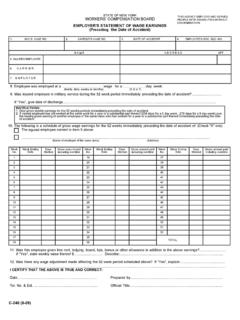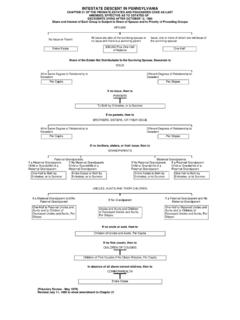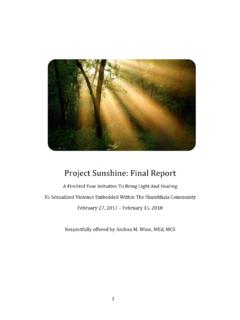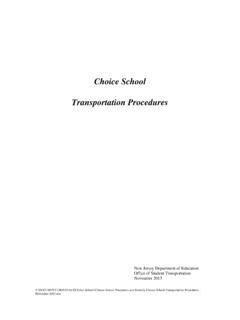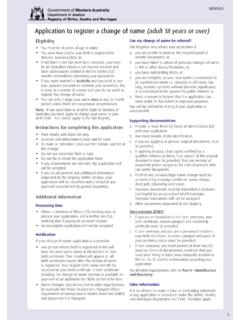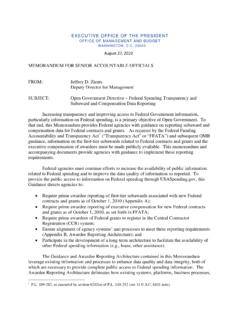Transcription of SLEDAI-2K Responder Index 50 (SRI-50) Definitions ...
1 Version 2, 29-Octob-2010 (Copyright University Health Network) SLEDAI-2K Responder Index 50 (SRI-50) Definitions Descriptors are present at the time of the visit or in the preceding 30 days Numerical scale: 1is mild and 10 is most severe To determine body surface area use Rule of Nines for skin scoring: Head 9%, chest 9%, abdomen 9%, back 18%, legs 36%, arms/hands 18% and mucous membrane 1%; physician s palm for 1%. * Overlap of symptoms will count for only one descriptor either Psychosis or Organic Brain Syndrome. # Lupus headache improvement will count regardless of whether patient is using narcotic analgesia or not though it has to be part of the baseline lupus headache. CVA and Cranial Nerve improvement will count if it occurs within 1 month from the event on the basis of decrease in lupus disease activity as this more likely on the basis of decrease disease activity.
2 Vasculitis, Rash and Alopecia; if the total BSA 1%, a 50% improvement is defined by 50% decrease in the activity of the most active lesion by decreasing by 2 grades or 50% decrease in the number of lesions or decrease in the size of the biggest lesion with no worsening in either. DESCRIPTOR SLEDAI-2K DEFINTION DEFINITION OF SRI-50 IMPROVEMENT Seizure Recent onset. Exclude metabolic, infectious or drug causes. 50% reduction in frequency of baseline seizure days/month. Psychosis* Altered ability to function in normal activity due to severe disturbance in the perception of reality. Include hallucinations, incoherence, marked loose associations, impoverished thought content, marked illogical thinking, bizarre, disorganized, or catatonic behavior. Exclude uremia and drug causes. 50% improvement of the psychotic manifestations judged by physician.
3 Organic brain syndrome* Altered mental function with impaired orientation, memory, or other intellectual function, with rapid onset and fluctuating clinical features. Include clouding of consciousness with reduced capacity to focus, and inability to sustain attention to environment, plus at least 2 of the following: perceptual disturbance, incoherent speech, insomnia or daytime drowsiness, or increased or decreased psychomotor activity. Exclude metabolic, infectious or drug causes. 50% improvement of the organic brain manifestations judged by physician. Visual disturbance Retinal changes of SLE. Include cytoid bodies, retinal hemorrhages, serous exudate or hemorrhages in the choroid, or optic neuritis. Exclude hypertension, infection, or drug causes. 50% improvement of the retinal exam assessed by physician. Cranial Nerve disorder New onset of sensory or motor neuropathy involving cranial nerves.
4 50% recovery of motor or sensory function in affected nerve within 1 month from the event on the basis of decrease in lupus disease activity or 50% decrease of the severity of pain within 1 month from the event on the basis of decrease in lupus disease activity as determined by patient on numerical scale of 1-10 if applicable with no worsening in either. Lupus headache# Severe, persistent headache; may be migrainous, but must be nonresponsive to narcotic analgesia. 50% decrease of the severity of pain as determined by patient on numerical scale of 1-10. CVA New onset of cerebrovascular accident(s). Exclude arteriosclerosis. 50% recovery of motor or sensory function related to CVA within 1 month from the event on the basis of decrease in lupus disease activity as determined by physician without worsening in either.
5 Vasculitis Ulceration, gangrene, tender finger nodules, periungual infarction, splinter hemorrhages, or biopsy or angiogram proof of vasculitis. 50% improvement of the vasculitis lesions present with no new lesion or worsening in either. A 50% improvement for ulceration or gangrene is defined as 50% decrease in the body surface area; for periungual infarction, splinter hemorrhages or tender finger nodules a 50% improvement is defined as 50% decrease in the total number of involved digits with periungual infarction, splinter hemorrhages and tender finger nodules. Multiple lesions in a single digit, count only one. Version 2, 29-Octob-2010 (Copyright University Health Network) The SLEDAI-2K -50 Responder Index (SRI-50) is a licensed work of the University Health Network. Permission for use of this instrument must be obtained from the authors.
6 Table 2. SLEDAI-2K Responder Index 50 (SRI-50) Definitions DESCRIPTOR SLEDAI-2K DEFINITION DEFINITION OF SRI-50 IMPROVEMENT Arthritis 2 joints with pain and signs of inflammation ( tenderness, swelling or effusion). 50% reduction in the number of joints with pain and signs of inflammation ( tenderness, swelling or effusion). Myositis Proximal muscle aching/weakness, associated with elevated creatinine phosphokinase/aldolase or electromyogram changes or a biopsy showing myositis. 50% increase in muscles power judged by physician or increase by or 1 grade upon a scale of zero to five or 50% decrease in the level of creatinine phosphokinase/aldolase level comparing to previous visit with no worsening in either. Urinary casts Heme-granular or red blood cell casts. Decrease by 50% in the total number of casts (heme-granular and red blood cell casts).
7 Hematuria >5 red blood cells/high power field. Exclude stone, infection, or other cause. Decrease by 50% in the number of red blood cell /high power field at this visit. Proteinuria New onset, recurrent, or persistent proteinuria of more than > gram/24 hours. Decrease by 50% in the range of proteinuria. Pyuria >5 white blood cells/ high power field. Exclude infection. Decrease by 50% in the number of white blood cells/ high power field. Rash New onset, recurrent, or persistent inflammatory lupus rash. Activity of skin lesions should be based on the evaluation of the most active lesion. Decrease by 50% of involved body surface area and/or activity of most active lesion with no worsening in either. Activity of the lesion should be determined by the color of the lesions: 0 absent 1 pink, faint erythema 2 red 3 dark red/purple/violaceous/crusted/hemorrhagi c A 50% decrease in the activity of the lesion is defined by decreasing by 2 grades.
8 Dyspigmentation, scarring and atrophy are not active lesions. Alopecia New onset, recurrent, or persistent abnormal, patchy or diffuse loss of hair. Size of patchy alopecic lesion should be determined based on involved total scalp surface. Total scalp surface is Diffuse alopecia is determined by patient on numerical scale of 1-10. Activity of alopecia should be based on the evaluation of the most active lesion. Decrease by 50% of total scalp involved area for patchy alopecic lesion or 50% reduction in the diffuse alopecia as determined by patient on numerical scale of 1-10, and/or activity of the most active alopecic lesions with no worsening in either. Activity of the alopecic lesion should be determined by the color of the most active lesion: 0 absent 1 pink, faint erythema 2 red 3 dark red/purple/violaceous/crusted/hemorrhagi c A 50% decrease in the activity of the lesion is defined by decreasing by 2 grades.
9 Mucosal Ulcers New onset, recurrent, or persistent oral or nasal ulcerations. Decrease by 50% in the number of ulcers at this visit. Pleurisy Pleuritic chest pain with pleural rub or effusion, or pleural thickening. 50% reduction in the pain severity as determined by patient on numerical scale of 1-10 and/or 50% reduction in the amount of fluid (on imaging) with no worsening in either. Pericarditis Pericardial pain with at least one of the following: Rub, effusion, electrocardiogram or echocardiogram confirmation. 50% reduction in the pain severity as determined by patient on numerical scale of 1-10 and/or 50% reduction in the amount of fluid (on imaging) with no worsening in either. Low Complement Decrease in CH50, C3, or C4 below the lower limit of normal for testing laboratory. 50% increase in the level of any complement or normalization of one of them without a drop in either.
10 Increased anti-DNA antibodies levels Increase in the level of anti-DNA antibodies above normal range for testing laboratory. 50% reduction in the level of anti-DNA antibodies. Fever >38 C. Exclude infectious causes. 50% reduction in the degree of fever above normal. Thrombocytopenia <100,000 platelets/ x 109/L. Exclude drug causes. 50% increase in the level of platelets but <100,000 platelets/mm3. Leukopenia <3,000 white blood cells/x 109/L. Exclude drug causes. 50% increase in the level of white blood cells but <3,000/mm3.
